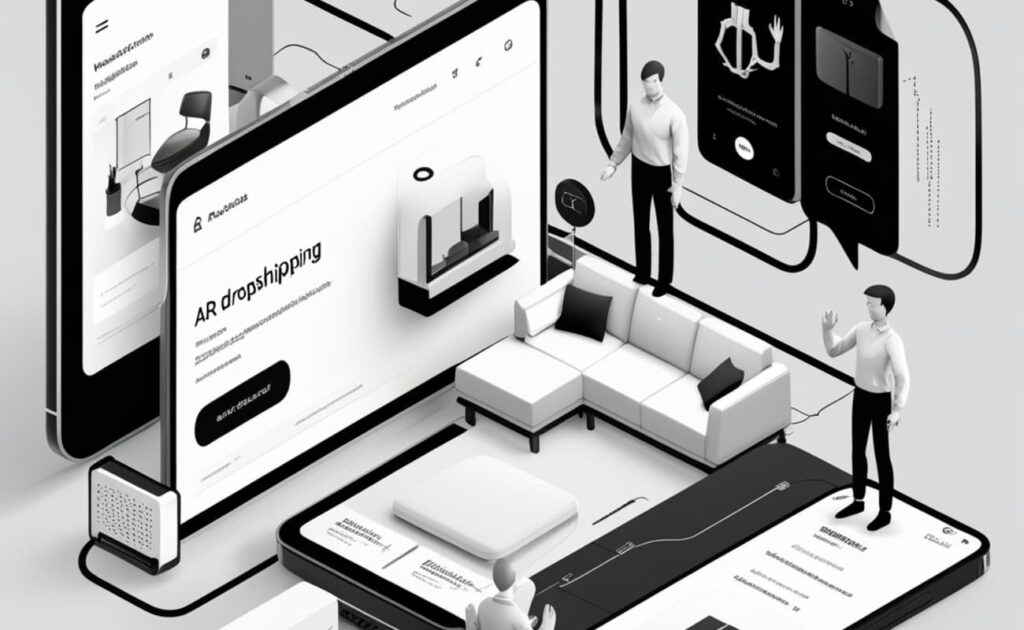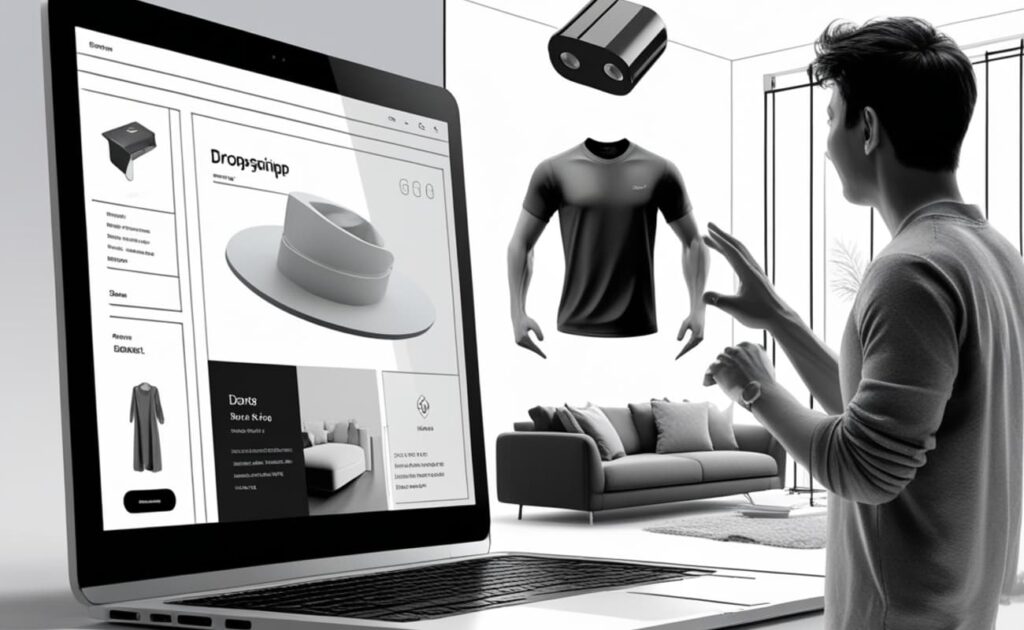In today’s dynamic digital landscape, augmented reality (AR) is not just a buzzword but a revolutionary tool transforming the way businesses operate. Particularly in the world of dropshipping, AR dropshipping is emerging as a secret trend that can radically enhance customer experience, drive conversions, and ultimately skyrocket your sales. If you’re a teenager stepping into the global e-commerce arena or an aspiring entrepreneur seeking innovative ways to stand out, this article is your gateway to understanding how AR can be implemented into your dropshipping model to achieve unprecedented growth.
The Rise of AR in Dropshipping
Imagine a customer browsing your online store and being able to see a 3D preview of a product right in their living room before making a purchase. With AR dropshipping, this possibility becomes reality. The integration of AR into dropshipping platforms not only enriches the customer journey but also instills confidence and trust in your products. By removing the guesswork associated with online purchases, AR dropshipping effectively reduces the rate of returns—as much as a 35% decline in some cases—and increases conversion rates significantly. This trend is particularly exciting when compared to traditional dropshipping models, where static images and vague descriptions were the norm.
Platforms like Shopify AR and Threedium are at the forefront of the AR dropshipping revolution, offering cost-effective solutions for businesses of all sizes. My personal experience with AR dropshipping implementation has been nothing short of transformative; the ability to present products in a virtually interactive manner makes the entire shopping process more engaging and customer-centric. Are you ready to dive into the practicalities of AR dropshipping integration in your business?
Practical Steps to Implement AR in Your Dropshipping Business
Integrating AR into your online store might seem daunting at first, but breaking it down into manageable steps can demystify the process. To truly grasp the benefits of AR dropshipping, consider this clear perspective: by allowing customers to virtually interact with products before buying, you create an engaging experience that outshines competitors using traditional methods. Service providers like Shopify AR, Threedium, and even niche strategies such as Sada dropshipping, HR dropshipping, and HHC dropshipping are paving the way with platforms and case studies that demonstrate tangible results in AR dropshipping.
Understanding the Workflow
At its core, the AR dropshipping integration workflow involves capturing realistic 3D models of your products, integrating them into an AR-friendly interface, and ensuring seamless compatibility across devices—especially mobile platforms. This process, while technical, offers a tremendous payoff when executed correctly. For instance, a case study revealed that one online store experienced a 40% increase in conversion rates after implementing AR dropshipping previews, which allowed customers to virtually ‘try’ the product in their own space.
During implementation, it’s essential to focus on two primary areas: enhancing the visual representation of your products and ensuring the technical compatibility of your AR dropshipping solution. The transition phase may require additional resources, but the long-term benefits such as reducing customer hesitation and boosting sales make the investment worthwhile. Have you ever wondered how a realistic product preview through AR dropshipping could change your customers’ buying behavior?
Case Study: AR-Driven Conversion Boost
Let’s take a closer look at a real-world example. A mid-sized dropshipping store integrated AR dropshipping technology into its product pages using Shopify AR. By providing customers with immersive 3D previews of the products, the store managed to achieve a remarkable 40% increase in its conversion rate. What made this store successful wasn’t just the technology itself—it was the seamless experience offered to the buyers. The interactive previews allowed customers to view products from different angles, zoom in to inspect details, and even visualize the product in a context similar to their own environment.
This case study highlights the advantage of merging practicality with innovation through AR dropshipping. When customers feel more confident about the quality and fit of a product, hesitation is minimized, leading to a more satisfying shopping experience. This enhanced buyer confidence is a core reason why dropshipping businesses incorporating AR dropshipping, whether via traditional AR dropshipping methods or specialized techniques like Sada dropshipping, HR dropshipping, or HHC dropshipping, are witnessing extraordinary growth.

Utilizing AR Dropshipping Platforms: Shopify AR and Threedium
Two platforms that have garnered considerable attention in the realm of augmented reality are Shopify AR and Threedium. Shopify AR stands as an extension of the popular Shopify ecosystem, enabling even novice dropshippers to implement AR functionalities with ease. Threedium, on the other hand, is known for its robust AR capabilities and scalability across different product categories. Both platforms offer user-friendly interfaces that help you get started quickly without requiring extensive technical knowledge.
Are you aware of how these platforms can provide you with an edge over competitors? With the right AR integration, you not only elevate the user experience but also create a memorable brand interaction that can drive customer loyalty over time. Embracing such technologies positions you at the cutting edge of e-commerce trends, enabling smoother transitions from product discovery to purchase decision.
Analyzing Challenges and Finding Solutions
No revolutionary change comes without challenges, and AR dropshipping is no exception. The primary hurdles include the need for advanced technical resources, ensuring mobile compatibility, and handling the potential complexities of 3D content creation. These issues can be particularly daunting for those who are new to AR technology. However, the long-term benefits—like significant improvements in conversion rates and a substantial reduction in product returns—often outweigh the initial investment of time and capital.
Businesses must approach AR integration as a gradual process, starting with a pilot program and expanding from there based on user feedback and performance metrics. By doing so, you minimize risks while still reaping the benefits of this innovative technology. Have you considered how taking incremental steps towards full AR integration could allow your store to scale sustainably?
Benefits and Impact: A Comparative Overview
To better understand the multifaceted impact of AR on dropshipping, let’s break down some of the key benefits in a simplified table format. This table not only highlights the primary areas of improvement but also compares the outcomes of traditional dropshipping with those of AR-integrated models.
| Key Feature | Impact | Notes |
|---|---|---|
| Realistic 3D Product Previews | +40% Conversion Rates | Customers can visualize items in their own environment, leading to improved purchase confidence. |
| Enhanced Product Interaction | Reduced Returns by 35% | Interactive previews ensure customers know exactly what to expect, minimizing post-purchase disillusionment. |
| Cost-Effective Platforms | High ROI | Platforms like Shopify AR and Threedium offer scalable solutions for all business sizes. |
| Improved User Engagement | Increased Customer Loyalty | An engaging interface builds brand trust and facilitates repeat purchases. |
This concise comparison makes it clear that AR isn’t merely an add-on feature—it’s an integral component that reshapes the entire e-commerce experience. With AR dropshipping, you’re not only enhancing the aesthetic appeal of your products but also ensuring that every buyer interaction is as immersive and compelling as possible.
Integrating AR Into Your Existing Dropshipping Strategy
If you already have a dropshipping business, adding AR elements can be transformative. Start by assessing the current performance of your website and determining which products would benefit the most from a 3D preview. It may be tempting to overhaul your entire site, but a phased approach often works best, allowing customers to acclimate to the new interface gradually. Moreover, AR integration should be seen as an ongoing resource rather than a one-off upgrade—it requires regular updates, monitoring, and improvement to keep pace with ever-evolving customer expectations.
This transition demands a blend of creativity and technical prowess. However, with the array of resources now available—ranging from detailed tutorials offered on reputable sites to support communities centered around platforms like Shopify AR—the process becomes more accessible and manageable. The question is, are you prepared to leverage your current assets and embark on this innovative journey?

Looking Ahead: The Future of AR Dropshipping
The future of dropshipping is intrinsically linked with technological advancement. As AR technology continues to mature, expect to see further innovations that will further mold consumer behavior and redefine online shopping. Trends suggest that not only will AR dropshipping become more prevalent, but it will also spawn innovative forms like HR dropshipping and HHC dropshipping—niche methodologies that add another level of personalization and efficiency to product marketing. These trends signal a broader shift towards interactive and immersive commerce, driving businesses to continually adapt and innovate.
Looking ahead, the integration of AR into dropshipping is not just a fleeting trend but a long-term strategy that promises sustained growth. As augmented reality tools become more user-friendly and affordable, even small to mid-sized dropshippers can harness their power to compete with larger enterprises. Moreover, the ongoing evolution in mobile technology will likely enhance AR functionalities, ensuring that customers enjoy high-quality experiences regardless of the device they use. So, are you ready to embrace this future and transform your dropshipping business with AR?
Connecting With Other Dropshipping Innovations
As you explore the benefits of AR dropshipping, you might wonder how this trend integrates with other innovative dropshipping strategies. For instance, related approaches like Sada dropshipping, HR dropshipping, and HHC dropshipping are all carving out niches in the market by addressing specific customer needs and optimizing operations in distinct ways. Each of these methods has its unique focus, yet they all share the common goal of leveraging technology to enhance user experience and operational efficiency.
For a deeper dive into modern dropshipping trends, you can check out our detailed article on dropshipping salary. This piece offers insights into how dropshipping can provide not only a scalable business model but also a path to financial independence—especially relevant for young entrepreneurs and tech-savvy individuals venturing into e-commerce. Additionally, visiting our homepage at Smarteconomix can provide you with further resources and articles to fuel your e-commerce journey.
External Resources for Further Reading
To expand your knowledge on the technical aspects and latest trends in AR technology, visiting resources such as the Shopify AR page can provide detailed information on integrating AR into your dropshipping platform. Staying updated with such resources ensures that your strategies remain at the cutting edge of technology and consumer expectations.
Frequently Asked Questions (FAQ)
What exactly is AR dropshipping and how does it work?
AR dropshipping involves integrating augmented reality technology into your online store so customers can view interactive, 3D models of your products in a real-life context. This immersive experience not only boosts confidence in the product but has also been shown to increase conversion rates and reduce product returns.
How does Sada dropshipping differ from traditional dropshipping?
Sada dropshipping is a niche approach that often incorporates innovative technologies like AR to enhance the shopping experience. Unlike traditional dropshipping which relies on static images and descriptions, Sada dropshipping leverages immersive visuals and interactivity to create a more engaging customer journey.
What are the benefits of HR dropshipping?
HR dropshipping typically focuses on utilizing advanced technologies and data analytics to optimize both marketing and operational efficiency. By integrating features such as AR, businesses can create personalized experiences that not only drive conversions but also foster long-term customer loyalty.
Can HHC dropshipping help in reducing product returns?
Yes, HHC dropshipping, which often includes augmented reality applications, allows customers to virtually preview products in their desired environment. This clarity helps set accurate expectations, leading to a significant reduction in product returns.
Are the platforms like Shopify AR and Threedium suitable for beginners?
Absolutely. Both Shopify AR and Threedium have user-friendly interfaces and offer plenty of support and resources to help beginners integrate AR into their dropshipping model without requiring extensive technical expertise.
By understanding the potentials and challenges of AR dropshipping, you are now better equipped to embrace this revolutionary trend. Whether you’re exploring related concepts like Sada, HR, or HHC dropshipping, the future of e-commerce lies in creating immersive, interactive experiences that resonate with modern consumers. Now, it’s your turn: how will you leverage AR to transform your online business?
